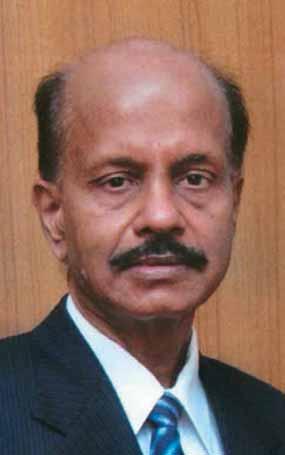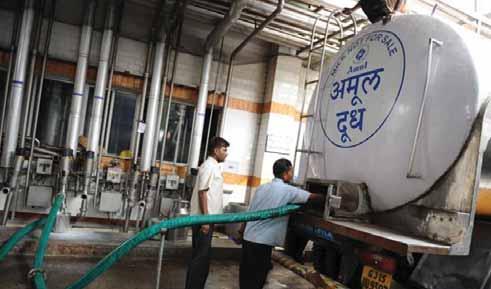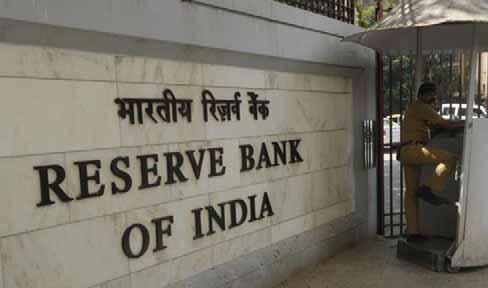Budding Managers - February 2015
Budding Managers - February 2015

How amazing it is to look around us and see very simple people who live a simple life, yet teach great values! I`d like to pen the greatness of little things that we miss out to understand from around us. Just thought of sharing one such encounter that I had with a simple man, Natraj who is entrusted with the duty of watering the grass/plants grown under the Over-Bridge as part of ‘Singara Chennai’. I see him every other day as I cross the bridge while I wait for the signal, and Natraj is busy watering the grass and the plants. Wait......I hear you say ‘Hey! What`s strange or special about this stuff? It`s just a normal event all of us pass by.’ What really caught my attention was, as Natraj was watering the plants, he kept on uttering something to himself all the while till he completed the duty of watering the plants in the entire area. He also kept a smiling pleasant face while uttering those words. First time when I noticed Natraj I just took a casual look and passed by. What intrigued me was, after about 2 weeks of observing Natraj`s act every single day while I crossed the bridge - Natraj Waters the plants with a smile and muttering something to himself (Thanks to the traffic signal that gave me the time I needed to watch Natraj and what he does). It`s been several months now, of observing the same act of Natraj. My curiosity mounted and forced me to get down and ask him what is that he kept on muttering with a smile all day and all the while watering the plants!
The reply that he gave made me feel how a simple man could teach great values. And that`s when I started to look at little things yielding greatness. As he does his daily duty of watering the plants he keeps on muttering the words, “The Fruit of my labor today will yield the best result”. Also Natraj said, “I keep a smile on my face all through my duty because my smile will be reciprocated in the form of the happiness that I get each day doing the duty for many years now.
The big lessons that I intend to put forth here is that “Devotion to duty is the highest form of worship to god”, reminding the quote of Swami Vivekananda.
Big Lesson 1:
Our duty beckons us to deliver our ‘Key Result Areas’. If WHAT WE DO decides the results of our labor then HOW WE DO (with Love) would decide the quality of the results. So, the job will yield the deserving result for your labor only when it is being done with utmost love. Or to simply put it – your dutifulness and diligence will give you the results and the DEGREE OF LIKING will determine the magnitude of your results.
Your degree of liking (for the job) ∞ Level of Results
Big Lesson 2:
I had once set out to ask 2 questions to all my friends who were working in organizations/ institutions just as part of my thesis. My first question was, “Why do you work there(Org) ?” and my second question was, “If you were sacked from your job what will you do?” I found that the fi rst question was pretty much easier for all the respondents to answer stating it is either the money or the brand image of the company or simply that they needed a job in a specific domain and also some in fact gave responses such as they could not get job elsewhere so they work here! For the second question, there were shocked reactions from them by stating, ‘I would be depressed, I would be angry or I would be feeling low and I will start a job hunt and so on..
All that I looked as an answer for my question was the simple, “I love what I am doing. So am here for the love of my duty” And for the second question I would have been convinced if any of them had replied without the tinge of shock that, “I love what I do and so I don’t depend on others , I will find a way to keep doing what I love doing.”
Remember, our efforts get multiplied when the dose of love is added to whatever we do. PASSION LOOSENS FRICTION. Apply this logic to any aspect of life.
While you work with utmost PASSION and you are deeply passionate about what you do, then the stress/challenges of your duty would seem to be a pleasure and no more a pressure i.e FRICTION. Thus concluding with the fact that passion and friction are 2 repulsive forces.
Higher the Passion->Lesser the Friction
Big Lesson 3:
On closely studying human minds and desire, we can consider ‘Desire’ to be a kind of force/energy and so equate it to Einstein’s` . Now look within you for any desire that you possess. The desire inside you gives you theenergy to move towards achieving the desire. So, going by this understanding, if your desire is so strong and innately intense, it will attract all the surrounding energy from every source and push you stronger in achieving your desire. This can also be related to the concept of ‘Law of Attraction’. The Love kindles your desire and ignites you to your results.
Greater Love for duty->stronger desire->High Positive energy
The greatest successes or the achievements does not stem out from the mere ambition rather it grows as a fruit of the Love of Labor or the Love for Duty. So it isn`t enough to simply set goals or being just ambitious. What it takes to reach the roaring success is your love for your duty. The unrelenting desire which breeds in as a result of your love will take you to excellence.
The 3 big lessons guide you with inside-out view onto your degree of the liking for your duty, the level of passion that you possess towards what you do each day in your job and finally the love, desire and energy equation. Whatever be the duty that you do, the value that you attach to what you do decides what you be and how you be! It`s the simple man Natraj and his little things of value that opened insights to greater thoughts and big lessons for us.

Stay Calm, Listen to your conscience and answer to yourself; “Is Your Love, Your Duty?”
BUDDING MANAGERS
FEBRUARY 2015 ISSUE

For India Inc, unarguably the most high profile top management appointment of the year gone by was that of Vishal Sikka. The 47-year-old was handed over the reins at India’s premium software exporter Infosys, being named its Chief Executive Officer and Managing Director on June 12. For Infosys, the induction of the former member of executive board and Global Managing Board at the German multinational software giant SAPSE was a drastic shift in multiple ways as the Bengaluru-based firm continued its journey towards rediscovering itself in a highly competitive information technology sector. Dr. Sikka is Infosys’ first ‘outsider’ to head the company, the first non-founder Chief Executive Officer of the technology biggie of the country. But that is just one of the deviations or that Sikka has already brought to the table.
Purely from a leader’s perspective too, Sikka’s placement could well be dubbed as a historic one in the annals of the illustrious company. One of the facts in his curriculum vitae that make Sikka stand out is his status as an expatriate. The Madhya Pradesh-born son of Punjabi parents who was raised in Gujarat city of Vadodara is currently an American citizen, based out of California. Information technology firms turned to expatriates is nothing new with Infosys itself had hired around 100 expats in the middle and senior management levels working in India a few years back.But a high profile positioning like of that Sikka was probably the first time an Indian IT major followed the footsteps of country’s several other major companies in varied sectors.
Sikka’s selection at Infosys follows the fast-picking trend of expatriates heading Indian companies as the firms look to spread their wings across the globe, expanding their operations to multiple countries, seeking more clients at newer overseas destinations and continuously looking to grow in terms of profile and revenues.
Complexities galore
Indian companies turning to expatriates or repatriates (Indians relocating back home) to lead the way has probably picked up in the last five to six years, with the ‘foreign’ heads primarily expected to bring in more professionalism to the Indian style of work culture besides introducing the home-grown companies to fresh strategies in line with the global standards. There is definitely an element of big risk involved in such appointments, with their success and full-level utility depending on a wide ambit of factors bordering complexity.
Even the status of being an expatriate itself is not devoid of its own complex features. According to definition provided by Investopedia, expatriate is an individual living in a country other than their country of citizenship, often temporarily and for work reasons and can also be an individual who has relinquished citizenship in their home country to become a citizen of another. Venturing beyond the broad definition, there are socio-economic factors involved in the usage of the term ‘expatriate’. Commonly, the term is used to refer to professionals or skilled workers working abroad, either being sent by their companies on overseas duty or those opting to work in a company in another country as in the case of Sikka, who is an American citizen now. So the term excludes the wider domain of ‘immigrants’ or ‘migrant workers’. Skilled professionals earning their bread in another country are described as expatriates, while the manual labourer who has moved to another country, again for economic reasons, might be categorized as an ‘immigrant’ or ‘migrant worker’. But the underlying contradiction here is that there is no hard and fast definition for expatriate and usage varies with context. The same person may be viewed as an “expatriate” by their home country but will be labeled as a “migrant worker” in the country he works. Interestingly, retirement abroad usually makes one an “expatriate”.

The trusted hand
In the context of Indian companies, a very limited talent pool and lack of expertise have led to a string of expatriate CEO or top-level appointments. Generally, there is strong inclination to enroll expatriates to head operations in an overseas location from the country of headquarters. So it is a natural ascension of sorts to have Makoto Kita as Managing Director of Mitsubishi Electric India, the Indian arm of the Tokyo-based automaker. Likewise, the Managing Director of Volvo Auto India is Tomas Ernberg, who had a globe-trotting childhood but has his family roots in Swedish town of Bastad, some 250 kilometres away from the auto manufacturer’s headquarters in Gothenburg. The rationale behind such appointments is primarily simple – to have at its helm those who know the company and its values well and those who can inculcate the same values and principles in a subsidiary operating in another country. These heads are those who can extend the legacy and expertise to another geographical area without compromising on the core business motives even while incorporating the culture and values of the overseas subsidiary. Then, there is this damage-control motive too behind such appointments. For example if things go awry in an overseas subsidiary, big corporates want people whom they can trust to handle the situation on hand and then would ideally choose from their trusted lieutenants to lead the recovery if it is a mess like an irregularity or fraud.
Hunting for talent
As Indian firms ranging from airline carriers to auto manaufacturers, telecommunication companies to to retail biggies along with pharma companies enhance their presence over a global scale and envisage a bigger role in overseas markets, the national borders begin to blur and priorities change for good where the main aim is to tap the cream of executive talent,

with those with the valuable experience of testing waters in world’s biggest and volatile markets. The Indian companies are now are willing to shell out big salaries in dollars for these coveted positions at the top.
However, the trend per se in the love affair with videshi top-level management personnel is to rope in experts with proven experience, who sometimes are absolute strangers to India and its culture when they are chosen to steer the Indian companies concerned.
“There is no trend considering the Indian companies’ sector as a whole. It depends on the demands required in any specific sector. What employers are looking for is a set of career skills and past experience and this trend has been picking up among Indian companies for the past five to six years. The ground reality is that sometimes the Indian companies lack personnel who own certain specialized skill set, particularly when these companies are looking to expand in the global arena. At the end of the day, it is their expertise and knowledge depth that matter and these are the elements that would make all the difference,” says Siddarth Raisurana, a Mumbai-based Director with recruitment services firm ABC Consultants.
In India, there are quite a few sectors which are in a nascent stage with respect to innovation, strategic expansion and technological incorporation. In some cases, traditional companies are looking beyond their strongholds while in other instances, new companies are setting their foot on fresh terrains, full of risks and complexities but are goldmines for growth opportunities at the same time. In certain sectors, companies follow the path trodden by their rivals by appointing expat experts and even then, the search process involved is quite tedious and time consuming with far-reaching consequences.
Specific fields
“Aviation industry, retail industry, oil and gas sector and commercial infrastructure, construction companies are the major sectors looking for expertise in Indian expats to lead their operations. It is their global experience that would come handy,” Raisurana told Budding Managers, underlining the vitality of these specialized sectors in need of expat leadership and wisdom.
The Indian aviation sector is a classic example for expat case study. Jet Airways, the second largest airline in India both in terms of market share and passengers carried, replaced Garry Kenneth Toomey with Australian Cramer Ball as CEO with the security clearance from government and regulatory approvals coming in the way of the new appointee in September 2014. Ball, who was instrumental in turning around the fortunes of Air Seychelles, has worked in several global airline carriers including Etihad Airways, Ansett Australia, Gulf Air, Kendell Airline and Qantas. Ball, who oversaw the restructuring programme at Air Seychelles, has a tougher job at his hand with the fledgling fortunes of Jet Airways, which started its commercial operations way back in 1993, against the backdrop of an already ailing sector in India. In the latest development of the management tale, the newest entrant in Indian aviation sector -- Vistara, a joint venture between Tata Sons and Singapore Airlines and beginning its operations early this year -- has found its CEO in Phee Teik Yeoh, the former executive of Singapore Airlines. The onerous challenge before Yeoh is to carve out a niche space for a full-service carrier like Vistara in a country marked as the hub of low-carrier flights and often witnessing their dogfight for survival. The expat CEOs come handy in the aviation sector particularly with their expertise in the finance and strategic planning areas. Effective support from promoters is the need of the hour for the expat CEOs to script a success story.

India in demand
Top expat executives have shown genuine interest and seek job opportunities in the world’s largest democracy, looking forward to embrace several challenges including leading the company in a new direction and that too at a vibrant stage where the scope of growth is quite wide. At least in certain cases, they try to give a global hue to the entire process in companies which thus far have rooted their operations and style of work to the native soil. Also, the growth in the economy has made India a lucrative learning ground for global managers and a valuable bullet under the experience column in their resume.
As per a survey of chief executives and expatriates conducted by the Indian arm of global executive search firm Amrop, the rise in demand for overseas talent has risen due to the rise of so-called sunrise industries such as organized retail and mergers and acquisitions besides the global expansion plans of Indian companies, searching for that vital competitive edge attained through fresh expertise and a new, inspiring leadership culture. Industry analysts are of the opinion that nationality is not a factor while choosing an expat leader as the priority is given for specific work-oriented skills.
For any India-based company with multinational ambitions for expansion, it is ideal to nurture as second string of Indian executives who would be ready to take over the leadership mantle in the next three to five years. Hence, able guidance for the junior level of executives is also an important quality companies look for in their expat CEOs. The transition is crucial when the Indian companies believe they had had enough experience in the area and then turn their attention to better bottom line and higher cost efficiency. In late 2013, Aditya Birla Retail Ltd, a part of the Aditya Birla Group, announced the exit of Russell Berman as the CEO of its hypermarket business at the end of his seven-year contract and replaced him with Vishak Kumar, the then head of the supermarket business who joined as a management trainee in 1995.
The company also assigned Kumar the twin roles to head both the formats. Retail analysts then had opined that the under-pressure retail environment forced the company to streamline the operations, pushing an Indian to the helm of the affairs.
Insurance fi rms too eye expats regularly for top management positions in finance and actuarial services, as the local talent pool falls short of the requirements in a sector in India which is just a fraction of what it is in a major market like the United States.
Obvious challenges
There is the obvious flipside for the expat CEOs handling affairs in Indian companies. When Sikka says the biggest challenge facing Infosys in 2015 “will be bringing a cultural shift” and insists on the “need to change mindset, focus on innovation”, the new CEO knows exactly what he is talking about, things he would have expected before taking charge.
Right from the typical hierarchical modes of behavior including the refusal to call your boss by his first name to being excessive emotional while reacting to constructive criticism, the Indian job culture may come under a big shake-up under an expat CEO. The lack of punctuality can be a regular headache for the CEO and equally challenging is how to cope with these drawbacks without being a dictator at work.
Some expat CEOs point out that the Indian staff lack the understanding of work-life balance. A classic example for this is to send a mail to your colleague at the day-job work right in the middle of the night.
“It is a tough job to change the mindset of the people working with the organization and it is easier said than done. It is really challenging for a CEO or any top-level management personnel to effect this change of thought right through the organization,” opines Raisurana.
Without doubt, the role of an expat CEO in India is a give-and-take one. As an expert, you provide your valuable inputs to steer the ship forward and in return, keeping aside the perk and status, you acquire that immense experience of working in one of the melting pots among emerging markets across the world. It is a win-win situation for sure.
BUDDING MANAGERS
FEBRUARY 2015 ISSUE

We have already set our feet on the fresh path namely 2015 and the year 2014 is past now, fading away from us with each passing day. Quite often than not, a New Year ushers in lot of hopes and tons of optimism tagged with the customary horizon of unbridled excitement. Everyone loves to fancy the start of each and every year, the January month of the modern day Gregorian calendar, as the metaphoric sunrise, the dawn which filters in fresh rays of vibrant light reflecting the wide band of good fortunes. Each New Year is linked to high hopes of prosperity and rich expectations on one’s own betterment and improvement. Each one of us wishes to view the freshest year in our life as something that benefits us and brings in a bagful of goodies, irrespective of what the previous year had dished out.
In tune with the overwhelming tone of the ‘beginning phase’, resolutions prove to be the buzz at this time of the year with many plunging into oaths and promises of various depths and sizes, wishing to overcome the obstacles, both mental and physical, to scale down a specific target.
Resolutions vary in terms of the individual engaged, circumstances involved and also by the degree of toughness. You can take up a resolution to cut down on your body weight, one of the most common and predominant tasks that people tend to embrace regularly. Although all resolutions unarguably involve an individual signature, there can be goals set for a team or group effort with you putting the money on your role or contribution towards the entirety of the effort. Reading a particular number of books in a year can be daunting if your work schedule doesn’t allow you to spend more time for reading on a daily basis even as you desperately try to keep the weekends off the radar, devoting the time to wind down from the hectic time at work.
Mental scars
For most of us, it starts as an apparent serious challenge and ends as a casual promise broken.Still we keep taking up resolutions, keep breaking them consistently and yet again think in advance about the next year’s resolution. In the outset such constant breakages might look simple and mundane, but the psychological scars resulting from those little failures can be far reaching, negatively affecting the morale of the person in question.
An element of distrust can creep in slowly, sometimes harming your confi dence to go ahead in areas that are even completely unrelated.
According to a research conducted by University of Scranton and cited in an article published by Forbes a few years back, only a minute eight percent of people who undertake New Year resolutions manage to tackle the several
barriers and finally soar past the finish line, enjoying the successful attainment, that unique satisfactory experience. To avoid failures on the resolution front, it’s important to follow a few rules of thumb. Putting these rules into application, one can fetch the goals in style and in time, effectively raising one’s own confidence level, strengthening one’s own will power and widening the chances of fulfillment on to multiple areas.
Baby goals
Careful planning is an ideal prerequisite for any resolution programme, with the focus on simple, specific goals that you think is attainable and are also realistic. Any sort of stretching, either mental or physical, should be kept in cold storage so as to pencil in on tiny targets. As the saying goes, even a journey of a thousand miles begins with a single step. Baby challenges will help you focus on the job at hand, enjoying the process towards acquirement of a specific goal.
A recall of your past challenges, even if they were utter failures, would do a world of good as it would help you self analyse the situation, dwelling specifically on your strengths and weaknesses, recognizing the possible points of tripping and understanding the phases that require a more guarded approach. A repeat attempt on a failed old resolution can be more meaningful and creates a high possibility of fruition during the current try if you make use of such go-to-the-past exercises.
A visual reminder about the progress on your resolution can be handy and any model in the form of graphs or charts can be used for this purpose. And, the goals should always be linked to achievable metrics that are rational as well.
It is also preferable not to commit to too many tasks at one go. For example, it is better not to club together weight losing and time management targets together.
The chances to secure both the goals at same time are not impossible but the triumphant rate would be definitely higher if you opt for one of the goals at one time and pursue the second one by rescheduling it for another slot. However, there is no harm in stitching up two tasks that are correlated. Staying away from smoking can become part of weight losing goal as well.

From a job perspective, the resolutions can be related to something personal like better management of your leaves or something more official, like the decision to devote more time for a specific target assigned to you.
The sharing trick
There is another group who believes that sharing your resolution with someone close to you can beget positive results.

Firstly, the sharing process will obviously create more pressure to keep up the word. You feel more responsible when another person knows about the promise you have to hang on to. Secondly, the person with whom you share the resolution can provide suitable suggestions and useful tips, presuming that the he or she knows and understands you and your depth of character and will.
Gifting yourself for each mile covered is another way of keeping the resolution concerned alive and kicking. The rewarding system tows along a plethora of advantages that are critical to your way forward with the resolution. It motivates you to keep going with your goal and will also help to enjoy the process as a whole as there is a possibility of monotony pulling you down every now and then. A nice balance in the rewarding process is a definite need. A minute reward won’t keep you charged while if you over-compromise with a big reward for a tiny step of success, things can turn around for bad in no time with you falling in the trap of complacency.
If you are starting the process in January, like in a majority of cases, and if you sustain through the first month, there is every possibility of you making the cut in an effective manner. But there are numerous cases of persons falling by the wayside by the halfway stage -- that is by the June month -- and statistics reveal that by the end of July, more than half would have succumbed to distractions and temptations.
A successful attempt with a resolution can be beneficial in multiple ways. The boosting of your self esteem and confidence takes the cake. With successful completion of one resolutional ready in the kitty, you will be inspired to take up more challenges and after already tasting success with specific goals at one point of time, you can even stretch the frontiers by aiming at tougher challenges lying ahead for you.
Now it is time to decide on your resolution, pull your socks up and stay happy all through the year!
BUDDING MANAGERS
FEBRUARY 2015 ISSUE

On the hockey turf, Viren Rasquinha was a workhorse, the quintessential halfback, the brain behind each attacking move. Six years ago, the Olympian and Junior World Cup winner quit his playing career at 28, an age where many continue to crave for more laurels, leaving his vast legion of fans in disappointment. A studious boy at school and one of the brightest hockey captains the country has seen, Rasquinha didn’t leave his dream of contributing to sports. After securing a post graduate degree in management from the prestigious Indian School of Business in Hyderabad, Rasquinha joined Olympic Gold Quest as its Chief Operating Officer, a position he continues to revel in. A football fan at heart who supports Liverpool and Real Madrid, Rasquinha is all sweat and blood these days, hunting down goals, soaring up in that constant bid to touch the sky-level dreams. Also a strategic advisor and mentor to the newly-owned Mumbai franchisee in the Hockey India League, Rasquinha is a busy figure at home too, cuddling his seven-and-a-half-month old daughter Maya. The effervescent Mumbaikar took time off hectic schedule to share with Team BM his views and vision on sports management.
How important is the educational qualification in sports management compared to the experience of being just a former player?
It is important to hold a degree. When you talk about management, it is like running a company. It is very essential to get the relevant knowledge. Core sporting knowledge is essential as a sports person but you have to be a thorough professional in terms of understanding numbers, finances, balance sheet, marketing etc. Just being a sports person is not enough though it’s one of the key components to become a successful sports manager.
What prompted you to take the management plunge by cutting short your young career as a sports person?
I never wanted to play for India for a very long time. I always wanted to create an impact as a player and do something that people should always remember me. As a player I always gave 200 percent and it’s same with OGQ.
I wanted to be involved in sports. I love sports and understand sports. I believe I can make a big difference in sports in the country. It was important for me to learn the other aspects of sports being run as a company. My stint with ISB was a transition period for me where I learnt a lot with my peer group and it has helped me in my career at OGQ.
How do you analyze the Indian spectrum evolving in the past decade or so?
Sports have started playing a far more significant role in the last 10 years with lot of leagues mushrooming across different sports events. The Indian sporting industry is slowly maturing and gradually become more professional. More job opportunities are there and highly skilled, educated young talents are attracted to the sports industry. If want to build a mature sports industry, we need to attract more talented people into the industry.
What are the fresh challenges facing the sports management personnel in India?
There are many challengers. Sports in this country is still run in a very ad hoc manner. We need to improve the functioning of national sports bodies, the organizational capacity of state-level bodies is very unprofessional. Sports should not be the fallback choice for the people, it should the first choice.
How your vision and overall take on sports has changed by being part of OGQ?
OGQ is involved in a very niche space in terms of supporting the training of athletes preparing for the Olympics. We aim to be the best in the world in what we do. We can’t do everything under the sun in sports. Whatever we do, we want to make an impact.
Any touching experience as COO of OGQ?
When Mary Kom won her Olympics medal, it was four years of hard work before that medal came. When she finally won that medal, me and my team were almost crying buckets of tears. When someone wins at the highest stage, that makes it all worth it.
How important is for a sports person to handle success?
That’s a very key part in being a sports person at the very highest level. A part of being a top-quality sports person is staying grounded, treating success and defeats as impostures and keep improving and be good role models. Mental conditioning and positive attitude do play a role in all of this. As a sports person in India, you face a lot of challenges and you to need to be strong enough to overcome those.
Do you think the sports management courses available in the country are fi ne-tuned to the Indian circumstances?
We need better professional courses, we need better teaching. Curriculum and the quality of teaching should be given significant attention. Right now, the educational opportunities are not good enough.
There are many who are passionate about sports they follow but haven’t played it at the same time. Do you suggest the course for such aspirants who have seen the sport from only a distance and have never been part of a dressing room?
Alex Ferguson was not a world-class player but he became a world-class coach. To be in the sports management profession, you need not play at the Olympics or at the highest level for that matter.
Inherent understanding along deep love and passion for the sport and an understanding of how the Indian market works are required.
Finally, what is your advice for any sports management aspirant?
Read a lot on sports to understand what is happening in India and across the world. Pick an area within the sport where gaps are there that can be filled in by you. A revenue model is one such area.
The most important thing is you should be passionate in what you are doing.
BUDDING MANAGERS
FEBRUARY 2015 ISSUE
Whether it is that firm click on the mouse or the soft touch on your laptop or the gentle push on your smartphone, sending emails is part and parcel at any white-collar work. The frequency of the routine may vary, the number of mails handled may differ each day and the time span of reception or sending may remain inconsistent, but you just can’t walk away from the act or rather the inevitable responsibility. Whether interacting with your manager, or communicating with your colleague, or taking up a matter with the human resource personnel, or dealing with day-to-day clients, emails have become the norm. Emails have turned to be the indispensable ingredient that tacitly complements your job profile. Still, many don’t realise the significance or sensitivity attached to emailing and just go through the motions, approaching the vital communication aspect with the same casualness of sipping morning coffee.
Like many of the cut-and-dry things in our life, emailing will remain an smooth, mundane, effortless procedure unless you commit hara-kiri and things go horribly wrong following which the reality dawns on you that emailing is not that simple as you had though. The must-have realization, which would serve you better in the future, is that emailing has to be learned and with a little bit of caution, with the aid of a more professional approach, you could master the drill too.
JUDGMENT FACTOR
The content of a mail is probably the most vital part of emailing. Right from the subject handled to tone of the language to probable grammatical or spelling errors, emails demand an eye for detail. Content judgment is the tricky part here. What to exclude becomes as crucial as what to include in the mail. For example, salary-related issues should better be discussed only with your manager or human resource staff. It is ideal to keep a safe distance from any sensitive issue. So the golden rule is when in doubt, stay away from it.
And, if the issue is so tempting to be put in to the mail, a feasible choice is to discuss it with a trusted colleague.
Being a communication tool, you need to comprehend that there is a recipient or multiple recipients for every email you send and to put the persons at the other end at ease should be a top-most objective. Hence, easy readability of the mail is a must. In order to ensure that idea conveyed is not lost among long paragraphs, it is better to break up the content. Effective use of bullets, numbers and lists can help to split the content. Effective usage of subject line too is equally vital because it is the first thing the recipients will notice. An attractive, to-the-point subject line can make all the difference whether a recipient will open or delete the mail. If your mail requires urgent attention, mention ‘important’ or ‘urgent’ in the subject line.
Proofreading is a sine qua non which should be given first priority. Typos, wrong punctuation, poor grammar and careless use of cases can damage your name as well as make the reading more cumbersome for the recipient. If you are inattentive to details and mistakes creep in, you and your work will be branded sloppy. On the other hand, a precise, perfect mail can create a magic feeling. Brevity is a necessitous asset to have while handling emails and if you spend more than 10 minutes to key in an email, chances are high that your mail is long and winding. You must understand that more people have no time for your long mails. Sweet and short – these are the key facets of good emails. Be direct with your writing and state the message in a non-convoluted manner so that the reader should not be dragged to read the mail from start to end to understand its gist. Always try to be courteous in your writing as a ‘please’ or ‘thank you’ can have wonderful effects in the response of the recipient. The use of too much first person in the mail too can be avoided.

THE OTHER END
Deciding on whom to send the mail when there are multiple recipients involved is vital. Here too, seeking advice from a trusted colleague is the preferred option. If you are in doubt about who should be receiving your emails, ask your manager for guidance. Do wait till the very last minute before you key in the list of names in the recipients’ list. That is the deterrent as an accidental hit before completing the mail can lead you to trouble. Write the mail first and keep the addressing part as the penultimate step, before sending. You need to be extra cautious while using the ‘reply all’ button and send the mail only to those required. If you are unsure whether everyone who needs to be addressed are not mentioned in the address list, then conclude your message with a polite request to forward the mail to those you have been missed by mistake. If you feel that there is scope for misinterpretation of your mail, fi le it in the drafts folder and go through it multiple times before ensuring a delivery with a stamp of clarity on it. Do not copy people in your mail but for a valid reason to do so. Follow hierarchy or alphabetical order depending upon the situation at hand while keying in the recipient list and be consistent with the order followed.
Also, be careful while sending attachments as many prefer not to open an attachment which is unfamiliar rather than risk any virus or such harmful elements. It is more likely that the recipients will read the matter if you put a hyperlink to the document in the body of the mail than an attachment.
The use of weird fonts, distracting colours and heavy graphic should be skirted. Skip the usage of all caps as it is suggestive of rudeness or impoliteness. Utilising lowercase alone can bit you back as it sensed as a casual way of communication, devoid of any seriousness and purpose. To highlight key words, employ asterisk or exclamation mark.
It is preferable not to send personal mails using the company server. Use your office infrastructure and hours for work-related mails alone. Refrain from sending mails with strong emotional taste as such mails will do more harm than good and may affect your reputation.
Forward mail is another issue that needs to be managed well. You may get loads of forwards, sometimes harmless jokes and cartoons, but stay away from further circulating them among your colleagues. A cool joke may hurt someone whom you might not even have thought about at that instance and even if one of your colleagues have forwarded it you, don’t entertain others to send such materials to your mail in the first place and refrain from sending it to a wider audience. In case where a mail snowballs into an embarrassing, controversial issue, you might be held responsible for forwarding the matter and fingers will be pointed at you as well as the original sender.
ON THE RIGHT SIDE
Understanding the general cyber laws of the land and specific rules at your workplace besides the company policies is needed. A basic understanding will ensure that you are on the right side of the law each and every time.
For someone in a managerial role, email should not be used as a tool for training your team members and should not be a substitute for face-to-face meetings. Mails do have tones, that are mostly very subtle, and it may be difficult for at least some to grasp the tone.
Just like sending, responding to an email also requires a guarded approach. Besides periodic, regular search of your inbox, you need to reply to the mails on time. Delay you response only if there is a good, rational reason. Missing a mail sent by your manager can be embarrassing, particularly if it was related to an important task to be taken up on a time-bound manner. Assigning folders with set rules for your higher-ups as well as for different categories can make the screening and filtering of your inbox more comfortable.

BUDDING MANAGERS
FEBRUARY 2015 ISSUE

The Indo-US ties went several notches up last month. Personal chemistry between US President Barack Obama and Prime Minister Narendra Modi cemented the relations further as Mr Obama wrapped up his over 50-hour India tour. Breaking the protocol, the prime minister received the Obamas at the airport and set the tone for the successful two-day summit.
The photographs of Mr Modi serving tea to Mr Obama in the sprawling Hyderabad House garden aptly captured the personal bonhomie between the two leaders of the world’s largest democracies. Mr Obama’s visit was significant in many ways. It was a first by the US president to grace the Republic Day celebrations as chief guest. It was also the first time that a US president in office visited India for the second time - Mr Obama had visited India earlier in 2010.
Getting down to business, both the countries managed to agree on many important deals, which can push the bilateral trade to greater heights from a minuscule $62 billion. The proposed $ 4-billion in investments and loans by US government agencies in India are a shot in the arm for the prime minister’s pet projects. The US financial support includes $2 billion of leveraged financing for renewable energy investments in India through the US Trade and Development Agency and $1 billion in loans for small and medium businesses across the country through the Overseas Private Investment Corporation.
The US president’s move to set up a high-level US-India strategic and commercial dialogue ensures that big plans on paper materialise on the ground.
Mr Modi’s reiteration of measures to ease business environment and usher in a predictable tax regime offers strong assurance to US investors of a changing business climate in the country. The summit has strengthened defence relations between the two countries with joint combat exercises and intelligence sharing mechanisms.
Besides, joint manufacturing of four relatively modest military products and exploring development of two more high-end technologies are set to bolster India’s fledgling defence-industrial base.
The biggest takeaway of the summit, of course, is the seeming breakthrough in the Indo-US nuclear deal. The pact signed in 2005 has been in limbo for a decade now. The stumbling block is India’s Civil Liability for Nuclear Damage Act, 2010. Foreign nuclear power companies are miffed by a few clauses of the law, framed to ensure that victims of a nuclear accident get quick compensation.
Two such clauses make equipment suppliers along with nuclear plant operators liable to civil suits by accident victims and mandate them to offer compensation over and above the Rs 1,500-crore limit set by global conventions.
Ironically, these clauses were forced into the Act by the BJP when it was in opposition. The BJP government is now working around these clauses to operationalise the vital Act that can boost the country’s nuclear power. As a way out, India has proposed to set up an insurance pool of Rs 750 crore and remaining Rs 750 crore of the total Rs 1,500 crore to be provided by the government.
Experts, however, are sceptical if the solution can withstand judicial scrutiny. The Act will have to be amended to provide clarity and remove any misgivings. Then there are a lot of irritants before both the countries, such as intellectual property rights and high visa cost, among others. Of course, a single summit cannot address all sticky issues. The Modi-Obama meet has broken new ground in bilateral ties. Y ears to come will prove if the summit did sow the seeds of a new Indo-American era.
BUDDING MANAGERS
FEBRUARY 2015 ISSUE
BPL Techno Vision (BTVL) is betting big on home automation. A part of the Bengaluru headquartered BPL Group, BTV L recently forayed into home automation and expects Rs 500 crore of business from the segment in the next five years. The company is also looking to expand its product portfolio in the LED (light-emitting diode) lighting segment after having started with solar lanterns about a year ago.
“Based on the current indications and interest levels in home automation, we see this segment contributing around Rs 500 crore to our overall top line in the next fi ve years,” reveals BPL Techno Vision CEO K VijayaKumar. The home automation segment has the potential to grow by 25 per cent compound annual growth rate in the next five years, he adds.
The company markets its automation solutions under the BPL IQ brand and is a pioneer in wireless intelligent home automation solution in India. “ BPL’s foray into the home automation sector has been ahead of its current competitors. Our solution stands a good chance with Indian consumers because it is flexible, simple to use, has advance wireless technology and can be retrofit in homes,” stresses Mr Kumar.
BTV L, a subsidiary of BPL, the leading electronic goods manufacturer of the early 1990s, has 30 dealers pan-India and is looking at expanding its sales network in coming years. “The response from the channels has been very good, which is why we are working on increasing the number to 50 immediately,” adds Mr Kumar.
BPL has designed and developed the automation system indigenously, and all its products are manufactured by BTV L. The home automation segment includes centralised control of lighting, HV AC (heating, ventilation and air conditioning), appliances and security locks.

“ We manufacture all devices at our Old Madras Road factory (Bengaluru) at BPL IQ Labs. The components that go into making these devices, which support wireless, intelligent, automation solution, are made in house. In fact, we have an installed capacity to reach top-line sales of Rs 500 crore,” discloses Mr Kumar.
According to Mr Kumar, the home automation segment has good export potential, and there is demand from overseas. “We are getting a lot of enquires from Qatar, Dubai and Singapore,” he notes, adding: “ BPL intends to include more products through introduction of more efficient and superior LED light sources.”
GLORIOUS PAST
The BPL Group, which in the 1980s and 1990s was a major consumer electronics player in the country, was established in 1963 by T P G Nambiar to manufacture precision electrical instrumentation.
Beginning as British Physical Laboratories, the company’s abridged name, BPL, became a big brand to reckon with. Starting from its core of medical electronics, it expanded into consumer electronics, telecommunication, soft energy and electronic components. During its prime, BPL would regularly feature among the top-10 brands in the country.
The founder chairman, TPG as he is widely known, slowly expanded his range to include electrocardiographs and patient-monitoring systems. The 1982 Asian Games, which introduced colour television broadcasts in India, convinced Mr Nambiar to enter consumer electronics. It was the collaboration and eventual joint venture with Sanyo of Japan that stood the test of time and brought BPL TV s to the drawing rooms of Indian homes.
However, a combination of circumstances brought this once-mighty group to its knees, with the current entity a pale shadow of its former self.
The reason for the decline included simultaneous expansion into several unrelated areas of business, a lack of financial discipline, entry of South Korean companies LG and Samsung and dissension in the family.

BRIGHT FUTURE
Five years ago, the crumbling BPL empire went into an internal restructuring and re-launched itself with each of its subsidiaries handling a core business. The group reconnected with the mass consumer market through BTV L by tapping rural and semi-urban markets through its rechargeable lighting systems for domestic households. With the brand recall and latest technologies, the company is making deeper inroads in the country.
BTV L has been smart in focusing on products of the future. Like home automation, the LED lighting segment too offers a great growth opportunity. The company is currently focusing only on the LED lantern market. In future, it is planning to venture into other forms of LED smart lighting for the lifestyle segment. It currently sells two models of solar-based LED lighting solutions - solar lanterns SL 1300 and Chirag.

The company is getting good response for the products and despite low key marketing efforts, it has sold more than 89,348 units since the launch last year, reveals Mr Kumar. “ We have a target to sell 2,7 5,000 units (lanterns) in this financial year. We will also be launching a new product line in the related category in the near future.
The products have become a preferred brand for microfinance companies and for companies driving CSR (corporate social responsibility) activities in rural India due to its affordable price,” he adds.
The BPL Group company’s lighting solutions are present over more than 5,000 points of sales. “In the coming years, we will naturally look at increasing our footprint to other regions that have not been tapped so far,” Mr Kumar points out.
"Based on the current indications and interest levels in home automation, we see this segment contributing around Rs 500 crore to our overall top line in the next five years."
K VIJAYA KUMAR
CEO, BPL Techno Vision
Both Central and State governments are pushing for a greater use of renewable-energy products. Moreover, by 2021, Karnataka and Kerala governments intend to make new laws for use of 3 to 6 per cent of the total energy in demand from renewable sources. “Subsequent to these findings, BTV L sees future growth areas in solar inverters and solar roof-top PV systems,” he foresees.
BPL has partnered with the Kerala government for its solar roof-top solutions. “We are very keen to partner with other State governments also who are launching the solar initiatives of self-metering. It is a matter of time before we associate with the Central government on a larger scale,” he adds.

India has a huge potential for LED smart lightings, the market for which was worth about Rs 2,000 crore last year, registering 46 per cent growth. Besides, rapid urbanisation has been pushing home automation as a smart solution in the fast-paced modern life. With the backing of brand BPL and an early-mover, BTV L could resurrect the fortunes of its parent company.
BUDDING MANAGERS
FEBRUARY 2015 ISSUE

India Inc’s mood of despondency has made way to hope. At the dawn of the new year, industry leaders are looking up to the eight month-old Narendra Modi government to revive the economy. From a vocal fault finder of the previous UPA regime, the captains of industry have turned into cheerleaders for the new government. If the corporate world was crying loud about policy paralysis and slow decision-making process during the UPA rule, it has been riding high on promises of achche din (good days) made by Prime Minister Modi. India Inc’s new year wish is for these positive sentiments to turn into real action on the ground now.
Good start
The government, in the meanwhile, has unleashed a slew of reforms to attract greater investments, including higher foreign direct investment (FDI) in defence and railway infrastructure. It has relaxed labour laws and launched campaigns, like the Make In India for re-invigorating manufacturing, Clean India and Digital India, among others.It has also promulgated an Ordinance to facilitate e-auction of coal blocks for private companies for captive use and allot mines directly to State and Central public sector undertakings. Another Ordinance has facilitated increase in the FDI limit for the insurance sector to 49 per cent from the earlier 26 per cent. The government has also enabled promoters of big projects to seek online green clearances, enhanced validity of industrial licences to three years and taken a number of other steps to cut red tape, promising instead a red carpet for investors. The corporate sector is happy with the government’s initiatives, like the Shram Suvidha portal to ease labour compliance norms, re-launch of financial inclusion scheme Jan Dhan Y ojana and plans to build smart cities. It is hopeful that the next Union Budget would make progress on these and many other issues.
“A quick return to a 7 to 8 per cent economic growth trajectory in the next year is not likely. It would take at least two to three years.”
AJAY SHRIRAM
President, CII

Long wish list
Overall, the industry remains hopeful that things will be better soon and the promised good days may indeed arrive in 2015. It is allowing the new government to settled down and be in a stronger position to start delivering on its promises. Despite the bullish mood, there are some voices of concern. But they are now being voiced behind closed doors or at off-media industry meetings. Industry leaders expect the quick rollout of the much-delayed Goods and Services Tax. They want the government to expedite clearances, revive stalled projects and get the economy back on track. They hope that the new government will reopen the chapter of high economic growth in the new year.
“In the first few months, the government has set an appropriate policy direction and tone to lead India back to high growth.”
JYOTSNA SURI
President, FICCI
BUDDING MANAGERS
FEBRUARY 2015 ISSUE
The Confederation of Indian Industry (CII) has been advocating for changes in existing policies and regulations to create an enabling environment for micro small and medium enterprises (MSMEs). For a long time now, the CII, one of the country’s leading trade associations, has been making concerted efforts to facilitate policies for reviving the vital engines of growth. In an interview with IBJ, K Nandakumar, the chairman of the CII’s SME Sub-Committee(Western Region) and CMD of Chemtrols Industries, talks about the industry body’s initiatives in bringing MSMEs to the centrestage of economic growth.

What is the present status of MSMEs in the country?
MSMEs hold a pivotal position in growth of the Indian economy by contributing around 37 percent to the country’s GDP (including services), about 45 per cent to its industrial production, over 40 per cent to its exports and account around 15 per cent of the total employment. But according to a World Bank study, as many as 60 per cent of Indian SMEs shut shop within seven years of establishment, 35 per cent remain stagnant and only 5 per cent survive the challenge of doing business in India. Therefore, the government must address the issues and concerns of the sector to make a scalable improvement in the ease of doing business in the country.
Despite a deluge of government schemes, why are small businesses languishing?
Most of these schemes are growth enablers. However, many critical issues which affect sustainability of MSMEs need to be addressed and resolved in an expeditious manner. The CII has been regularly interacting with both Central and State governments to get many of the issues addressed. Besides, we have put forward our suggestions on some of the critical issues.
Would you highlight some of the CII’s suggestions?
The Central government should ensure that its procurement policy for MSMEs is strictly enforced and see that its various ministries, departments and Central public sector undertakings adhere to the policy in letter and spirit. The State governments too should formulate and implement their respective, State-level, public procurement policies with grievance redress and monitoring systems. Adequate measures must be taken to address the issue of delayed payments to small enterprises. The clauses of the MSME Development Act,
2006, pertaining to delayed payments, need to be implemented in their entirety. Factoring of receivables should be made mandatory after a delay of say a maximum of 45 days. There should be mandatory disclosure of the amount due to MSMEs in annual reports of companies.
Defaults should be penalised, and timely payments can be incentivised. Apart from these, there should be comprehensive overhaul of labour laws with far-reaching labour reforms. There is a need for redesigning bankruptcy laws to help viable companies in distress by making it easier for entities to close and restart venture. The norms concerning listing of securities by MSME units should be relaxed so that they don’t act as a disincentive.
How do you see the outlook for MSMEs in the next few years?
India’s GDP growth rate is expected to attain the 8.5 per cent level in the medium term, and by 2025, India is expected to be a $ 4- trillion economy. The share of manufacturing MSMEs in the GDP is targeted to touch 15 per cent by 2020 from the present level of 7 per cent. The sector’s contribution in creating employment is expected to be over 300 million jobs. Moreover, new opportunities will emerge in sectors as wide as telecommunication, electronics, ICT (information and communication technology), media, wellness, pharmaceutical, automotive, defence and aerospace - to name a few - in fulfilment of the government’s mission of Make In India and Digital India.
BUDDING MANAGERS
FEBRUARY 2015 ISSUE

WHAT GREAT BRANDS DO
Authored by Denise Lee Yohn
Published by Jossey –Bass,
262 pages
INR 599
As the title firmly points out, the book is a take on branding. The book has the subtitle ‘the seven brand-building principles’, describing what the work is all about in one sentence. Yohn, an in-demand consultant and speaker, makes a sincere effort to elaborate about the practicality of branding, trying to answer many of those questions that are often left in the realm of vagueness. In a warm conversational way, the book talks in detail about inspiring examples of organizations that have done it the right way and also about the cautionary tales of who have failed to make the cut. The founder of GigaOM, OM Malik, says “Yohn has bottled the elixir of brands and the magic behind brands in this book”.
Dealing with the seven principles that represent a provocative view of branding, Yohn, who has worked with Burger King, Land Rover, Frito-Lay and Sony among others, tries to look at branding, commercial branding that is, with a new perspective, a fresh pair of eyes. Banking on compelling case studies and practical tools, the work demystifies the brand-building process. “When employees, vendors, customers and the community feel like a part of ,” the brand, that’s when the magic happens,” says Kip Tendell, chairman and Chief Executive Officer of Container Store. Yohn, a contributor to The New York Times, The Wall Street Review and Harvard Business Review, uncorks that magic for you with a book which serves as a guide for someone looking to grasp what branding is all about.
THE ROADSIDE MBA
Authored by Michael Mezzio, Paul
Oyer, Scott Schaefer
Published by Macmillan,
279 pages
UK pounds 12.99
The story behind the birth of the book itself is as enticing as the first thoughts leading to the establishment of a start-up firm. The author trio, economists and US professors who have taught thousands of MBAs at leading business schools, dropped into a shoe store in Mcine while travelling back from an economic conference together. They chatted to the staff and realized the strategic problems faced by small businesses are as rich and compelling as anything challenging Microsoft or GE. That visit provoked them to think differently and to undertake a journey to study cases of specific interest. In that learning series of drives, they meet diverse and versatile businessmen, including Mike Bodart in Indiana who bought the sports shop he adored as a kid and Vietnam veteran Phil Oakenshield, who is into the business of processing human waste.
The book thus turns out to be a rollicking American road trip that is both a helpful initiation for business owners who haven’t done an MBA and an entertaining refresher dip for those who already holds a degree. The work discusses various topics including product differentiation, setting places, managing the brand, negotiating in an effective manner, the hiring part, incentive for employees and also on how to battle the big brothers around. The book comprises 10 chapters besides the prologue and epilogue. The book is a fantabulous guide on how to deal with issues surrounding small businesses regularly and advices on ways to challenge the bigger rivals and the art of dealing with employees.
LEADING DIGITAL
Authored by George Westerman,
Didier Bonnet, Andrew McAfee
Published by Harvard Business
Review Press, 292 pages
INR 1,250
Subtitled ‘turning technology into business transformation’, the book is not just confined to technology, media and entertainment and the title is slightly misleading from that point of view. The work highlights how large companies in traditional industries, from finance firms to manufacturing giants to pharma companies, are using digital power to gain strategic advantage in their respective field of play. The authors elaborately discuss principles and practices that lead to successful digital revolution. Based on the study of over 400 global firms including Asian Paints, Burberry, Caesar’s Entertainment, Nike, Procter & Gamble, Starbucks, Lloyd Banking Group, and Pernod Ricard, the book explains the transition in a clear two-part framework. After interviewing executives and examining the companies deeply, the book studies in detail how to invest in digital capabilities and how to lead the transformation.
How to engage better with the customers, how to digitally enhance the operations of a particular company and how to create a digital vision are the other topics covered in the book. The Chief Executive Officer of Health Services, Siemens, opines that Leading Digital is “an exceptional contribution to strategy and management practice”. A step-by-step take for leaders to follow, the book is a sincere attempt dealing with the building process of digital capabilities including creating customer experience, exploring core operations and reinventing business models. Under the topic ‘building leadership capabilities’, subjects covered include crafty digital vision, developing the technology leadership capabilities and understanding the transformation from a closer distance.
BUSINESS ADVENTURES
Authored by John Brooks
Published by John Murray
Learning, 459 pages INR 399
The cover carries a catching quote by no less than Bill Gates, which itself makes you sit and think. Gates’ take is so compelling – “the best business book I’ve ever read”. The compilation of 12 classic tales from the world of Wall Street lives up to the high rating. It provides an entertaining look at the corporate and financial ilk in America. It hands over vital business lessons that could help the CEO of multinational and the aspiring founder of a start-up in equal measure. The $350 million Ford Motor Co disaster known as Edsel, the meteoric rise of Xerox as well as scandals in GE and Texas Gulf Sulphur become case studies in the book. Brooks quite fittingly proves that the fabulous and exciting accounts mentioned through various case studies are relevant in current world as they were in the past when the events happened, leading us to the labyrinths of corporate world. In narration of the accounts, there is enough drama involved and adventure galore, exposing the volatile nature in the world of finance.
BUDDING MANAGERS
FEBRUARY 2015 ISSUE

The Indian steel sector has been passing through tough times. The world’s fourth-largest steel producer has had to contend with high output and growing imports. While production grew at a pace faster than the global average for a significant part of 2014, demand broadly remained sluggish.
The vital sector is looking for a boost from the new government’s stated emphasis on manufacturing and infrastructure. Hoping to benefit from the Make In India programme, steel producers are targeting to expand their collective capacity well past 100 million tonnes per annum (mtpa) this year.
BAD PATCH
The sector continues to lag on a host of parameters. Production cost remains high, particularly for public sector undertakings (PSUs), limiting the industry’s prospects in various export markets. On the other hand, China is enhancing exports to India and other countries, and there is also a suspicion that the neighbouring country may be circumventing various duties. Among other Asian countries, Japan and Korea have started to reap the benefits of free trade agreements with India, leading to a rise in imports from the two countries.
While steel imports have been rising sharply and exports have been falling steeply. The problem has got compounded owing to sluggish trends in the domestic consumption, which has left a lot of unused capacity utilisation. This has forced steel producers to cut prices by 5 to 6 per cent due to higher imports, subdued domestic consumption and non-conducive global pricing trends. Global prices are unlikely to rebound soon, and they may come in way of any potential price hike by Indian steel-makers, thus affecting their margins.
TURN AROUND TIME
*Prices of vital raw materials like iron ore and coking coal on the decline
*Iron ore mines in Karnataka and Goa expected to reopen
*Coking coal mine acquisition by ICVL to shore up raw material stock
*Higher economic growth in coming years renewing steel demand
*Rapid urbanisation and rising demand from automobile sector adding buoyancy
*Government’s stress on manufacturing and infrastructure a big positive
BRIGHT PROSPECTS
The country’s per capita consumption is around one-fourth of the international average, and this keeps hope a float for an eventual recovery. There is good news on the raw material front as well. The steel industry is set to benefit from the fall in iron ore prices to a five-year low level. It will also gain from the declining coking coal prices. Analysts opine that prices of the raw material are unlikely to rise in the near term.The closed iron ore mines in Karnataka and Goa are expected to start soon, making the situation better for domestic steel-makers, many of whom had to resort to imports. A coking coal mine acquisition by International Coal Ventures (ICV L) - a joint venture of leading State-owned companies - in Mozambique would also help PSUs to shore up their raw material stock. The new year could turn positive for steel-makers if they can resist the surge in imports.
With raw material prices set to remain lower and demand likely to rise, the prospects for the steel industry look rosy, note analysts. As the economy is likely to grow at a higher rate in coming years, demand for steel will rise exponentially.A recent Frost & Sullivan report estimates the country’s steel production to touch 140 mt by the end of 2016 from about 100 mt in 2014.
Similarly, the report pegs consumption of the alloy to grow to 104 mt by 2017 from about 75 mt last year.
With infrastructure development and automotive industry driving steel demand, steel-makers could see bright years ahead, starting with 2015.
BUDDING MANAGERS
FEBRUARY 2015 ISSUE

Direct subsidy transfer for LPG kicks off
The government has unveiled the world’s largest direct subsidy rollout scheme, the Direct Benefit Transfer for LPG
Consumers (DBTL), across all the 67 6 districts of the country, covering 15.3 domestic cooking gas consumers. The scheme is aimed at an efficient subsidy delivery mechanism by curbing leakages.
Consumers’ bank accounts will be credited with Rs 568 as a one-time advance while they book their first LPG refill cylinder, starting from January 1. Every time a refill is delivered, the subsidy amount will be credited to the Aadhaar-linked bank account also linked with LPG connection.
Rs 8,000-crore IPOs likely in bullish 2015
Companies will be lining up initial public offers (IPOs) worth at least Rs 8,000 crore in 2015, according to capital market research firm Prime Database. This compares with mere Rs 1,528 crore and Rs 1,619 crore raised through public offers in 2014 and 2013 respectively.
Companies are aggressively tapping the capital market to fund business expansion and meet working capital requirements on expectations that the bullish trend in the stock market would continue. Videocon D2H, Lavasa Corporation, Adlabs Entertainment and Rashtriya Ispat Nigam are among companies planning to launch IPOs in coming months.
Govt’s pension burden to hit 4.1% of GDP
The overall cost of social security may jump up to 4.1 per cent of the GDP by 2030 from the current 2.2 per cent, notes a CRISIL report. The rating agency adds that the huge rise in social security cost on the government is because of the absence of adequate private sector coverage as the number of elderly will touch 18 crore by then.
CRSIL notes that by 2030, if at all the private sector coverage increases to 7 0 per cent in a best-case scenario, the government’s pension burden will be lower at 3.4 per cent of GDP.
SEBI’s new norms to fasttrack share sales
The SEBI has proposed a slew of measures to fast-track fundraising from markets. The capital market regulator has unveiled e-IPO norms, where investors can bid for shares through the internet and eventually on mobiles. Listed public sector undertakings and other companies will be provided a fast-track route for share sales through follow-on public offers and rights offers.
Under the new norms, the SEBI has proposed to cut the timeline for listing of shares drastically within two to three days of the IPO as against 12 days currently.
Only 5 . 5 % of huge tax dues recoverable
Only a small fraction of just over 5.5 per cent of the huge pending tax dues of Rs 8,25,000 crore, which individuals and businesses owe the government by way of direct and indirect taxes, is immediately recoverable.
The tax authorities are focusing their recovery effort on the small undisputed amounts as they are hindered by judicial restraints on recovery of a large part of tax arrears. Besides, a small part of the tax arrears is unrecoverable because assessees do not have adequate assets, reveals a submission made by tax departments before a Parliamentary panel.
Bengal gets over Rs 2 l cr investment pledges
West Bengal has received total investment proposals worth around Rs 2,43,000 crore spread across sectors, like education, health, mining, steel, infrastructure and financial services during the two-day Bengal Global Business Summit last month.

At the summit, West Bengal Chief Minister Mamata Banerjee announced that the State had set up a core team to monitor progress of investment proposals. She added that she too would review the progress of the proposals every three month.
Onus now on government to revive economy
With over-leveraged corporate entities and stressed banking assets, the onus of getting the economy back on track has fallen again on an equally stressed government, says an HSBC report. Quoting the Finance Ministry data, the report notes that during the September quarter of FY 15, the gross capital formation (GCF) was zero compared with the 10-year average of 9 per cent.
As a percentage of GDP, the GCF has fallen by over 4 per cent over the past five years as there was hardly any capex by both the government and private companies.
Open offers dip as stock prices rise in 2 0 14
As many as 61 companies made open offers to the tune of Rs 23,106 crore in 2014 under Takeover Regulations, according to a report by Prime Database. In comparison, 81 offers amounting to Rs 47 ,47 4 crore were made in 2013. As last year saw a strong, buoyant secondary market, an increase in stock prices acted as a deterrent for open offers, notes the report.
The largest offer last year was that of United Spirits for Rs 11,449 crore, followed by GlaxoSmithLline’s Rs 6,389-crore offer for GlaxoSmithKline Pharmaceuticals.
S&P Dow Jones Indices opens centre at BSE
Asia Index, a 50:50 joint venture between S&P Dow Jones Indices and the BSE, has opened a new operation centre at the BSE premises. The second-largest operation centre after its facility in New York will cater to the growing index-investing needs of the Indian market and provide back-office support for its global operations. The Mumbai centre will employ 60 people.

Essar exits teleom business worldwide
Essar Global Fund has completely exited its telecom business globally after selling all stakes in its telecom businesses worldwide for $6 billion (a little over Rs 37 ,000 crore). Essar Telecom Kenya, which operates the popular yuMobile telecom service in Kenya, recently sold its network, IT and office infrastructure to Safaricom, while Airtel has taken over its 26-lakh subscriber base.
The total deal value of the transactions is approximately $120 million (about Rs 750 crore). In 2011, it had sold its entire stake in Vodafone Essar for $ 5.2 billion (around Rs 23,500 crore).
Hoffmann-La Roche loses patent on Boniva
The Chennai patent office has revoked a patent of Hoffmann-La Roche for its osteoporosis drug ibandronate sodium, marketed under brand Boniva. The patent office issued the revocation order after hearing a post-grant opposition by Cipla afresh on orders of the Intellectual Property Appellate Board (IPAB).
The IPAB had remanded the issue to the patent office setting aside the earlier order of the patent office, which had refused Cipla’s post-grant opposition while granting the patent to the Swiss pharmaceutical company.
SR F snaps up DuPont’s Dymel for R s 12 0 cr
Arun Bharat Ram-led SRF has announced acquisition of Global DuPont Dymel, the pharmaceutical propellant business of American chemical giant DuPont. In an all-cash deal, SRF will pay a consideration of a tad more than Rs 120 crore for DuPont’s fluorochemicals business, which is a part of the performance chemicals segment that DuPont plans to hive off by mid-2015.
Under the transaction, DuPont will transfer the Dymel brand to SRF as well as the technology and knowhow for setting up its own manufacturing facility to make the unique pharmagrade propellants that do not emit ozone-depleting gases.
Bharat Forge arm buys France’s MGL
Bharat Forge’s German subsidiary CDP Bharat Forge has acquired a 100 per cent equity stake of Mecanique Generale Langroise (MGL) for 11.8 million euros (about Rs 85 crore). The acquisition is largely focused on further consolidating Bharat Forge’s position in the oil and gas sector. MGL based in Saint Goesmes, France, is a technology-oriented company focused on precision machining and other high-value added processes like cladding for critical application in the oil and gas industry.
The deal also brings Bharat Forge closer to its customers and increases the value addition provided to them.
Amul eyes Rs 50,000 -cr revenue by 2020
The Gujarat Cooperative Milk Marketing Federation (GCMMF), which markets the popular Amul brand of milk and dairy products, has drawn up a plan to invest at least Rs 5,000 crore to expand production capacities by more than a third over the next three years. The dairy giant, growing at around 24 per cent annually, expects to cross Rs 50,000 crore sales by 2020 from Rs 22,000 crore this year.

The world’s fastest-growing dairy organisation, currently ranking 15th globally, is planning to increase its processing capacity to 320 lakh litres a day from around 230 lakh litres currently.
Carnival on buying spree, acquires Glitz
After buying Anil Ambani’s Big Cinemas, the Carnival Group has picked up elder brother Mukesh Ambani’s majority stake in Stargaze, which operates the multiplex chain Glitz, for an undisclosed amount. Network18 Media and Investments, owned by Mukesh Ambani, announced last month that its venture capital unit, Capital18, had sold nine operational screens in Rajasthan, Madhya Pradesh, Chhattisgarh, Uttarakhand and Uttar Pradesh and one nonoperational screen.
The latest acquisition takes the Shrikant Bhasi-led Carnival Group, which has over 300 screens, closer to its top competitor PV R, which still leads with 462 screens.
Rs 100 -cr penalty on RSBL, NAC cancelled
The Directorate General of Foreign Trade (DGFT) has imposed a penalty of Rs 100 crore on Riddhi Siddhi Bullion (RSBL) and also cancelled its nominated agency certificate (NAC) for violation of RBI norms. NAC is the mandatory document needed for direct import of precious metals. According to the order, RSBL had obtained an NAC in April 2013 for direct import of bullion.
In FY 14, RSBL had imported 550 kg gold, and this entire quantity should have been exported back. However, RSBL had shipped back only 350 kg while the remaining 200 kg of gold was supplied to the domestic market, thus violating the NAC norms.
Bajaj Auto plans six launches in six months
Bajaj Auto is aiming to regain its lost share in the domestic two-wheeler market with six product launches in the next six months. The launches include a new 100-cc bike besides a 400-cc model under its flagship brand Pulsar. The company that had once looked away from the high volume 100-cc segment is looking to create a new space in the mass market as it eyes an overall share of more than 20 per cent in the domestic market by March this year from around the current 17 per cent.
Bajaj Auto trails market leader Hero MotoCorp but is ahead of Honda Motorcycle and Scooter India.
RIL reopens 230 of 1,400 fuel stations
Buoyed by diesel price decontrol, Reliance Industries (RIL) has reopened about one-fifth or 230 of its 1,400 fuel stations. RIL is planning to commission its entire network within a year. Essar Oil, the only other private refiner in the country, too has started diesel sales from all its outlets and expanded its network to 1,600. Essar is looking at increasing its fuel stations to 2,500 in a year.
RIL and Essar Oil had together captured about 17 per cent of domestic retail market for diesel and 10 per cent of petrol by 2006 before heavily subsidised sales by State-run companies took a heavy toll on their fuel sales.

Twitter acquires ZipDial in maiden India buy
Microblogging website Twitter last month announced that it would buy Bengaluru-based mobile marketing and analytics company ZipDial. The buyout of ZipDial, one of its product partners in India, will be Twitter’s first acquisition in the country. Neither Twitter nor ZipDial disclosed the size of the deal.
However, analysts peg the acquisition cost between $30 million (Rs 185 crore) and $ 40 million (Rs 250 crore). Founded in 2010 by Sanjay Swamy, V alerie Wagoner and Amiya Pathak, Z ipDial is a cloud-based mobile and analytics platform that allows companies to market their products to target audiences through so-called ‘missed calls’.
ICICI Bank unveils contactless cards
ICICI Bank recently launched contactless debit and credit cards that will work on nearfield communication (NFC) technology.
The new cards will enable customers to transact on a point-of-sale terminal by just waving them near the terminal. The technology provides customers an improved speed as they require significantly lesser time than traditional cards to complete a transaction.
Besides, the cards also offer enhanced security as they remain in control of customers. To begin with, the country’s largest private lender has set up 1,200 machines in Gurgaon, Hyderabad and Mumbai to accept contactless cards.
Lower inflation gets RBI to cut Repo Rate
The RBI last month effected a surprise interest rate cut outside the cycle of monetary policy decisions. The central bank also promised that there would more such cuts to follow as it signalled a shift to an accommodative monetary policy stance, citing lower inflation. The RBI cut its benchmark Repo Rate, at which it lends to banks, by 25 basis points to 7 .7 5 per cent from the earlier 8 per cent.
The Consumer Price Index-and Wholesale Price Index-based inflation for December had dropped to 5 and 0.1 per cent respectively.
NTT DoCoMo drags Tatas to arbitration
Japan’s NTT DoCoMo has filed an arbitration request against Tata Sons for failing to find a buyer for its stake in Tata Teleservices (TTSL). In March 2009, the Japanese company had acquired a 26.5 per cent stake in TTSL for Rs 13,07 0 crore. Under the terms of the shareholder agreement, the Tatas had to find a buyer by December 2014, and in case of failure, it had to buy those shares from DoCoMo.
In April 2014, NTT DoCoMo announced plans to sell its entire stake in TTSL after the Indian company failed to achieve certain performance targets.
NBF Cs permitted to fund cost overruns
The RBI has allowed non-banking finance companies (NBFCs) to fund cost overruns, which may arise on account of extension of date of commencement of commercial operation of infrastructure and non-infrastructure projects within specified time limits. The apex bank has permitted NBFCs to fund cost overruns without treating the loans as a restructured asset on certain conditions.
The conditions include funding cost overruns up to a maximum of 10 per cent of the original project cost and the debt-equity ratio agreed at the time of initial financial closure remaining unchanged subsequent to funding cost overruns.
New bank assurance norms on the cards
The IRDA is evaluating fresh norms for banks to act as intermediaries for insurers. The insurance regulator’s move follows recent changes in law brought by the government through the insurance Ordinance recently. According to the changes made through the Ordinance, banks (corporate agents), brokers and agents have all been now termed as insurance intermediaries. Accordingly, all intermediaries can seek partnership with multiple insurers.
The new regulation seems to have ended the one-bank one-insurer relationship, something the regulators have been seeking to change in the interest of consumers.
Banks seek relief in project cost overruns
Banks have urged the RBI to allow them flexibility in funding projects that have overshot the initial cost estimates by over 10 per cent. The RBI rules mandate that if the cost overrun is over 10 per cent, banks have to classify the account as restructured. Banks have requested the RBI to allow them to evaluate the cost overrun on an individual basis.
IOC to start Paradip refinery by March
Indian Oil Corp (IOC), the country’s biggest company, will begin commissioning its long-delayed, Rs 34,500- crore 15-mtpa Paradip refinery from the first quarter of 2015. The refinery in Odisha was originally to be built by April 2012 but has faced delays because of law-and-order problem.
The 11th refinery of IOC was to cost Rs 29,777 crore, but the delays have now taken the cost to Rs 34,500 crore. IOC, in the meanwhile, is equipping all its refineries to comply with the Bharat Stage-IV norms to meet the pan-India timelines.
Mormugao slots Rs 3,141 cr for expansion
The Mormugao port in Goa has lined up a Rs 3,141-crore expansion plan to expand its capacities across various facilities. The plan includes six projects for construction of berths and terminals at the port, including a Rs 950- crore project for development of multi-purpose cargo berth and a Rs 520-crore project for conversion of existing iron ore berth and ore-handling plant for general cargo. The other four projects worth Rs 810 crore include offshore liquid bulk holding berth, general cargo berth project instead of ship repair yard in the harbour area, development of the Vasco bay and development of dedicated berths for Navy and Coast Guard north of the Vasco Bay.
Liberty snaps Russian JV with OVL
ONGC V idesh’s (OV L) loss-making Imperial Energy venture in Russia has suffered a setback with its technology partner, Liberty Resources, walking out of the project because of US sanctions. OV L, the overseas arm of State-owned explorer ONGC, had roped in the Denver, US-based company in September 2013 to tap the Bazhenov shale formations in Siberia.

Liberty and OV L, which had done a lot of work on the Snezhnoye field earlier, had planned two horizontal pilot wells to explore oil from low permeability and hard-torecover tight sand reservoirs as well as Bazhenov shale in Imperial’s acreages.
Air India takes measure to slash costs
Loss-making Air India has announced a slew of cost-cutting measures, which include plans to cut reimbursements by 10 per cent and abolition of posts from non-operational areas. The national carrier has also decided to discontinue loss-making routes to rein in spending and return to break even.
The use of expensive or five-star hotels for stay during travel or holding events has been restricted and the budget for such activities has been reduced by 10 per cent. The airline’s net loss came down to Rs 5,389 crore in FY 14 as against a loss of Rs 5,490 crore in the previous year.
Kerala plans entity to tap remittances
The Kerala government is planning to fl oat a special outfit to tap investments of 24 lakh expatriates from the State. The proposed entity aims to channel the remittances to productive investment, especially in the State’s major infrastructure projects. The new outfit is planning to replicate the success of Cochin International Airport, the country’s first green field airport under the PPP mode, which could materialise by tapping resource-rich nonresident Keralites.
The details of the structure of the special purpose vehicle are yet to take a final shape. Kerala, accounting for 33 per cent of India’s total NRI remittances, had received Rs 72,000 crore from the diaspora in 2013-2014.
Government to allot PSUs 36 coal blocks
The government has kick-started the process of allocating cancelled coal mines to public sector undertakings (PSUs), with a plan to allot 36 blocks initially. Of these 36 coal blocks, one mine will be given to the steel sector, while the rest will be given to the power sector. The Coal Ministry will also be issuing guidelines for these blocks.
Accordingly, those companies which already have linkages will have to surrender them. The government expects to complete execution of allotment agreement by the end of the next month.
PSU banks to have separate chairman, M D
The government has split the post of chairman and managing director (MD) for PSU banks. For the first time, PSU banks, except for State Bank of India, will have a non-executive chairman, giving operational responsibility to MD and CEO. The chairman, who will not hold an executive position, will be a part-time board member who will preside over board meetings.
The bifurcation is based on the recommendations of an RBI committee, headed by A S Ganguly, in 2005. The committee had noted that chairmen often dominated banks’ boards during their tenure and called for separating the post to empower the board.
BUDDING MANAGERS
FEBRUARY 2015 ISSUE
